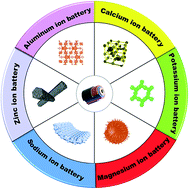Metal organic framework-based nanostructure materials: applications for non-lithium ion battery electrodes
Abstract
Non-lithium ion (e.g., Al3+, Ca2+, K+, Mg2+, Na+, and Zn2+) batteries have emerged as a promising platform for next-generation energy storage systems. Due to their high natural abundance, high theoretical capacities, and reliable and safe operation, non-lithium ion batteries have been considered as potential substitutes for lithium-ion batteries (LIBs) in recent years. However, progress in the development of non-LIBs has been obstructed by unique challenges for these systems, such as the relatively large ionic radius for the metals (e.g., Ca, K, Na), sluggish electrochemical kinetics, and limitations regarding the selection of compatible electrolytes. In this regard, researchers have targeted metal–organic frameworks (MOFs), which are crystalline porous frameworks with large specific surface areas and excellent synthetic tunability, chemical diversity, and stability, as prime candidates for use as high-performance electrode materials in non-LIBs. Herein, we summarize the recent contributions and progress of pristine MOFs and MOF derivatives as electrode materials for non-LIB applications, focusing on the aspects of rational design and sophisticated morphological control in the construction of MOF-based electrodes, in addition to evaluating the electrochemical performance of the resulting batteries. Finally, we highlight the opportunities and challenges for MOF-based electrodes for non-LIBs, and more broadly, offer our perspectives on the future development of non-LIBs.

- This article is part of the themed collections: Energy Frontiers: Electrochemistry and Electrochemical Engineering and 2022 Highlight article collection


 Please wait while we load your content...
Please wait while we load your content...